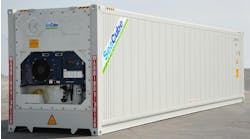FMCSA codifies windshield-mounted camera rule
A final rule from the Federal Motor Carrier Safety Administration (FMCSA) that took effect in May ensures windshield-mounted video cameras will remain compliant with newly amended Federal Motor Carrier Safety Regulations (FMCSRs).
The rule, published March 7 in the Federal Register, increased the area on the interior of commercial motor vehicle (CMV) windshields where certain vehicle safety technology devices may be mounted from “not more than 100 millimeters (4 inches) below the upper edge of the area swept by the windshield wipers” to 216 mm (8.5 inches).
The ruling, which FMCSA said was in response to a rulemaking petition from Daimler Truck North America, made permanent a temporary exemption the agency previously granted, ensuring camera systems like those utilized in Bendix Commercial Vehicle Systems’ Wingman Fusion collision mitigation technology permanently meet federal regulations.
See also: NHTSA updates rear impact guard standards
“This ruling marks another important step in the continuation of the commercial vehicle industry’s highway safety efforts,” said Fred Andersky, Bendix director of government and industry affairs. “The amendment will make it easier to implement advanced technologies that use multiple sensors … without fleets, drivers, and truck manufacturers having to worry about violating windshield clearance rules.
“It updates the regulation in favor of technology—not only for driver assistance systems but also for more automated driving systems that take advantage of additional sensors.”
In addition, units still must be mounted not more than 175 mm (7 inches) above the lower edge of the area swept by the wipers. Devices still are also required to remain outside the driver’s sight lines to the road, highway signs, and signals. And devices such as antennas or transponders mounted at the top of a windshield must be located outside the area swept by the windshield wipers. The amended rule also revises the definition of “vehicle safety technology” to add technologies that had been granted temporary exemptions previously.
In its decision, FMCSA noted it “believes that the rule has the potential to improve the safety of CMV operations. The agency also finds that CMVs outfitted with vehicle safety technologies under current exemptions do not present an increased safety risk compared to other CMVs.”
“We must also keep top of mind that drivers are—and will remain—critically important, and maintaining their ability to see the road is essential,” Andersky added. “The ruling effectively balances the needs of both drivers and the technologies designed to assist them.”



